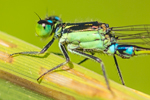When imagining the discovery of a new species, most people conjure thoughts of intrepid explorers, battling the odds in remote rainforests. But this needn’t be the case, at least according to a new study published in Zookeys. The study reports the discovery of a new species of water beetle in the heart of the 10th largest megacity in the world: Manila, Philippines.
During a routine training exercise for undergraduate biology students, scientists from Ateneo de Manila University discovered the unknown beetle hidden in the leaf litter of a small creek within the university’s campus.
 The new species Hydraena ateneo was found among leaf litter in a small creek of the Ateneo de Manila Campus. Photo Credit: H. Freitag, Ateneo de Manila University. |
The new species, Hydraena ateneo, named after the University in which it was found, is a tiny freshwater invertebrate measuring only 1-1.5 mm (0.04-0.06 in) in length. It is distinguished from similar species by its small size and by a characteristic straight section on its leg known as a metatibia. It belongs to the genus Hydraena, which are commonly known as long-palped water beetles. These are endemic to the Philippines, i.e. found no-where else.
New species are discovered every year in the Philippines, but they are mostly uncovered in natural forests and remote mountain ranges. The discovery of a new species in the heart of a city with a population of nearly 12 million proved astonishing to the researchers and students involved .
“I was so amazed that there are new species even in the Ateneo Campus in the middle of Manila,” said Arielle Vidal, a student enrolled in the training.
Although remarkable to discover a new insect in the middle of a city, the authors were not surprised to find a new species of the Hydraena genus.
“The long-palped water beetles are in fact one of the most overlooked and diverse genera of aquatic beetles. Only 14 species of this genus—all endemic—are known from the country by now, but many more wait to be named and described,” explained the paper’s author, Associate Professor Hendrik Freitag.
 This is a view of Metro Manila from the well-vegetated campus of the Ateneo de Manila University where the new species was collected. Photo credit: H. Freitag, Ateneo de Manila University. |
The new species was found in several other locations during the same workshop, leading the authors to hypothesize that the species had recolonized the area following extensive reforestation over the last 50 years. Such studies provide encouragement that reforested semi-natural landscapes within urban areas can still support significant biodiversity. However, the authors were keen to note that such encouragement should not be used to undermine existing conservation efforts.
“This should not lead to the illusion that the ongoing dramatic loss of biodiversity in the Philippines can be reversed,” cautioned Freitag. “A large proportion of endemic organisms are closely associated with primary forests. Therefore, it should remain a priority for nature conservation to protect the last remaining rainforests in the country.”
CITATION: Freitag H (2013) Hydraena (Hydraenopsis) ateneo, new species (Coleoptera, Hydraenidae) and other aquatic Polyphaga from a small habitat patch in a highly urbanized landscape of Metro Manila, Philippines ZooKeys 329: 9. doi: 10.3897/zookeys.329.5955
Related articles
New tiny insect named after Peter Pan fairy discovered in Central America

(08/16/2013) A new genus of fairyfly has been discovered in Costa Rica. The new species aptly named Tinkerbella nana after the fairy in J.M. Barrie’s play ‘Peter Pan’ is one of the smallest winged insects in the neotropics. Found in both temperate and tropical climates, the fairyfly is not actually a fly as its name suggests, but instead is more closely related to wasps – being classed within the superfamily Chalcidoidea, or the “chalcid wasps”.
New long-horned beetle discovered in China

(07/03/2013) Recent expeditions by the Chinese Academy of Science’s Institute of Zoology to the Yunnan Province of China have uncovered the existence of a new species of long-horned beetle. This newly discovered beetle has a beautifully colored blue-green body with short, slender, and distinctively blue legs according to a new article in Zookeys.
Pesticides decimating dragonflies and other aquatic insects

(06/18/2013) While recent research (and media attention) has focused on the alleged negative impacts of pesticides on bees, the problem may be far broader according to a new study in the Proceedings of the US Academy of Sciences (PNAS). Looking at over 50 streams in Germany, France, and Australia, scientists in Europe and Australia found that pesticide contamination was capable of undercutting invertebrate biodiversity by nearly half.